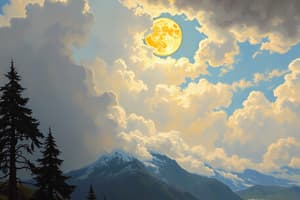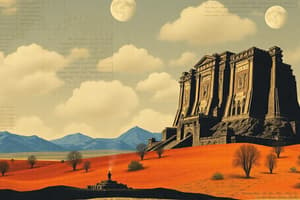Podcast
Questions and Answers
What does Earth science primarily study?
What does Earth science primarily study?
- The physical constitution of Earth and its atmosphere (correct)
- The mechanics of flight and aerodynamics
- The history of human civilization
- The structure of living organisms
Which branch of Earth science is focused on the study of the atmosphere and its processes?
Which branch of Earth science is focused on the study of the atmosphere and its processes?
- Meteorology (correct)
- Oceanography
- Geology
- Astronomy
Which of the following are included in the studies of geology?
Which of the following are included in the studies of geology?
- Planets and lunar phases
- Weather patterns and climate
- Oceans and tides
- Volcanoes and earthquakes (correct)
What is the primary focus of oceanography?
What is the primary focus of oceanography?
Which branch of Earth science studies objects beyond Earth’s atmosphere?
Which branch of Earth science studies objects beyond Earth’s atmosphere?
What topics are studied within geology?
What topics are studied within geology?
Which of the following is NOT a focus area of meteorology?
Which of the following is NOT a focus area of meteorology?
The study of the movement and life of organisms in ocean environments is part of what discipline?
The study of the movement and life of organisms in ocean environments is part of what discipline?
What caused the gas and dust particles to come together during the formation of the Earth?
What caused the gas and dust particles to come together during the formation of the Earth?
How old is the Earth estimated to be?
How old is the Earth estimated to be?
Which of the following is NOT one of the four geologic eons?
Which of the following is NOT one of the four geologic eons?
During which era did the earliest known life forms, like bacteria, appear?
During which era did the earliest known life forms, like bacteria, appear?
Which of these methods is used to determine the age of rocks through their radioactive contents?
Which of these methods is used to determine the age of rocks through their radioactive contents?
What is the correct order of the geologic eras?
What is the correct order of the geologic eras?
What significant process contributed to the addition of oxygen to the early atmosphere?
What significant process contributed to the addition of oxygen to the early atmosphere?
Which of the following statements about the Hadean Eon is true?
Which of the following statements about the Hadean Eon is true?
Which of the following organisms first appeared during the Paleozoic Era?
Which of the following organisms first appeared during the Paleozoic Era?
What was the climate during the Mesozoic Era primarily dominated by?
What was the climate during the Mesozoic Era primarily dominated by?
Which layer of the Earth is described as very hot and dense?
Which layer of the Earth is described as very hot and dense?
What percentage of the Earth's surface area is comprised of oceans?
What percentage of the Earth's surface area is comprised of oceans?
Which two elements compose a significant portion of the biosphere along with four others?
Which two elements compose a significant portion of the biosphere along with four others?
During which geological period did Pangaea begin to break apart?
During which geological period did Pangaea begin to break apart?
What is the main distinction of the Cenozoic Era compared to earlier eras?
What is the main distinction of the Cenozoic Era compared to earlier eras?
Which of the following describes the atmosphere?
Which of the following describes the atmosphere?
What is the primary composition of the Sun?
What is the primary composition of the Sun?
What is the maximum thickness a pedosphere can reach?
What is the maximum thickness a pedosphere can reach?
Which of these is NOT a type of rock found in the lithosphere?
Which of these is NOT a type of rock found in the lithosphere?
What is the effect of the Moon's gravitational pull on Earth?
What is the effect of the Moon's gravitational pull on Earth?
Which statement is true regarding planets in the solar system?
Which statement is true regarding planets in the solar system?
What occurs during an eclipse?
What occurs during an eclipse?
How long does it take for the Moon to complete one orbit around the Earth?
How long does it take for the Moon to complete one orbit around the Earth?
What are asteroids primarily composed of?
What are asteroids primarily composed of?
Flashcards are hidden until you start studying
Study Notes
Earth Science
- Earth science focuses on the Earth's physical composition, history, atmosphere, oceans, and its relationship with the neighboring space.
- Earth science is a multidisciplinary field.
Geology
- Geology involves the study of Earth's materials, structures, and processes.
- It focuses on minerals, rocks, volcanoes, earthquakes, faults, folds, soils, erosion, mountains, plate tectonics, and geologic history.
Meteorology
- Meteorology explores the atmosphere and how atmospheric processes influence Earth's weather and climate.
- It plays a crucial role in protecting Earth's environment.
Astronomy
- Astronomy studies the universe beyond Earth's atmosphere, including the Sun, other stars, planets, and other objects in the solar system.
- Astronomy is the oldest branch of Earth science.
Oceanography
- Oceanography focuses on the Earth's oceans, including their composition, movement, life forms, and processes.
- It deals with the life and properties of Earth's oceans.
Origin of Earth
- The Earth formed from condensing gas and dust approximately 4.6 billion years ago, according to the Solar Nebular Hypothesis (SNH).
- Gravitational forces caused the gas and dust particles to clump together, with heavier particles gravitating towards the center and lighter ones forming the outer layers.
- Contraction of the mass generated heat, causing melting and the formation of Earth's layers: core, mantle, and crust.
Age of the Earth
- The Earth is estimated to be 4.6 billion years old, determined by radiometric dating of the oldest rocks and meteorites.
Geologic Time Scale
- The Geologic Time Scale is a standardized method for dividing Earth's long history into different intervals:
- Geologic Eons: The largest unit of geologic time. Four Eons:
- Phanerozoic
- Proterozoic
- Archean
- Hadean
- Geologic Era: Eons are further divided into smaller units called Eras. The four Eras are:
- Paleozoic
- Mesozoic
- Cenozoic
- Precambrian
- Geologic Eons: The largest unit of geologic time. Four Eons:
Precambrian Era
- It's the oldest era, with minimal life forms, primarily bacteria.
- Oldest fossils were found in this era.
- Photosynthesis by seaweed introduced oxygen into the early atmosphere, paving the way for land life.
- The era saw the appearance of Stromatolites, single-celled plants (algae), approximately 3 billion years ago, considered the first life on Earth.
Paleozoic Era
- It's known as the "Age of Fishes" due to the proliferation of marine life: shellfish, fish, trilobites.
- Life also moved to land, with amphibians and ferns.
- The supercontinent Pangea formed during this time.
- First fungi, vertebrates, and insects emerged.
Mesozoic Era
- It's known as the "Age of Dinosaurs," with reptiles, including dinosaurs, dominating life on Earth.
- Birds also existed during this period.
- Forest trees appeared.
- Pangea broke apart.
- A mass extinction event at the end of this era resulted in the disappearance of dinosaurs.
- Archeopteryx, the oldest fossilized bird, was dated to this era.
Cenozoic Era
- It's known as the "Age of Mammals," with mammals becoming the dominant life form after the extinction of dinosaurs.
- Humans emerged during this era.
Structure and Composition of the Earth
- Earth has three main layers:
- Crust: The thinnest and most rigid outermost layer.
- Mantle: The middle layer, largely plastic.
- Core: The very hot, very dense center of the planet.
Earth's Major Spheres
- Atmosphere: The layer of gases and suspended particles surrounding Earth from ground level upwards, influencing environmental conditions.
- Composition of the Atmosphere: The atmosphere consists of various gases, primarily nitrogen and oxygen, with trace amounts of other gases.
- Hydrosphere: Includes all Earth's water bodies: oceans, lakes, rivers, underground water, glaciers, and snow.
- Chemical Composition of Seawater and River Water: Seawater and river water have different chemical compositions, reflecting their origins and interactions with the surrounding environment.
- Biosphere: The zone of life, a thin envelope extending about 8 to 10 km above Earth's surface and several meters into the pedosphere.
- Effects of Living Organisms on the Earth's Atmosphere: Living organisms have significant influences on the composition and processes of Earth's Atmosphere.
- Lithosphere: The rigid outer layer consisting of the crust and upper mantle, about 100km thick.
- Rock Types: Lithosphere consists of three main types of rocks: Igneous, Metamorphic, and Sedimentary.
- Pedosphere: The thin soil cover formed from weathering of rocks in the upper crust.
The Solar System
- Sun: The brightest object at the center of the solar system, made up of hydrogen and helium.
- Moon: A natural satellite orbiting a planet.
- Moon's Effect on Tides: The moon's gravitational pull creates tides on Earth.
- Eclipses: A phenomenon where an object enters the shadow of another object, blocking sunlight.
- Planets: Heavenly bodies orbiting the sun, with sufficient mass for their self-gravity to overcome rigid forces and assume a hydrostatic equilibrium shape.
- Asteroids, Comets, Meteors, and Meteorites: Debris in the solar system.
Studying That Suits You
Use AI to generate personalized quizzes and flashcards to suit your learning preferences.




